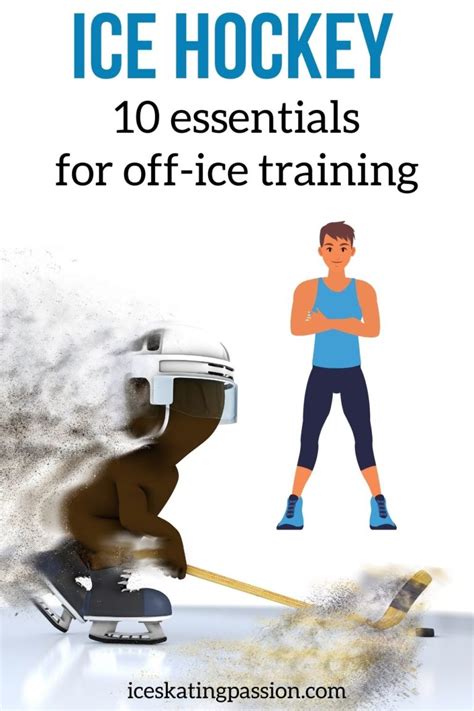Discover why off-ice training is crucial for hockey players, enhancing strength, skills, and injury prevention while tracking progress effectively.In the fast-paced world of hockey, on-ice prowess is just one piece of the puzzle; the foundation for success starts off the ice. Welcome to our exploration of the myriad benefits of off-ice training for hockey players. This integral component of training not only enhances overall performance but also plays a critical role in building strength, endurance, and technical skills. Whether you’re a seasoned player looking to refine your game or a beginner eager to establish a solid skill set, understanding the importance of off-ice training can significantly enhance your journey. Dive into this article to discover key components, injury prevention strategies, and effective ways to measure your progress, all designed to elevate your hockey experience and ensure you’re ready to shine on the ice when it counts most.
Why Off-Ice Training Is Essential For Hockey Players
Off-ice training for hockey has become an indispensable part of a modern athlete’s regimen. This type of training not only complements the physical demands placed on players during the season but also builds a foundation for long-term athletic development. Here are several key reasons why off-ice training for hockey is essential:
- Skill Development: Off-ice training allows players to focus on specific skills, such as shooting, passing, and puck handling, in a controlled environment. This helps improve their efficiency on the ice.
- Physical Endurance: Hockey is an intensely physical sport. Regular off-ice training enhances cardiovascular endurance, enabling players to maintain high energy levels throughout the game.
- Strength and Conditioning: A well-structured off-ice program targets muscle groups essential for skating, allowing players to develop the strength needed to withstand game pressures and off-balance situations.
- Injury Prevention: Off-ice training focuses on mobility, flexibility, and core strength, reducing the risk of injuries while maximizing performance on the ice.
- Team Cohesion: Engaging in off-ice training sessions with teammates fosters camaraderie, which can translate into better teamwork during games.
The commitment to off-ice training for hockey results in well-rounded athletes who are not only more skilled but also physically prepared to face the challenges of the sport. Consistent training off-ice can lead to improved on-ice performance, setting the stage for success in games and tournaments.
Key Components Of Effective Off-Ice Training For Hockey
Effective off-ice training for hockey plays a crucial role in the development of a player’s skills on the ice. The foundation of such training is built on several key components that ensure players are not only improving their physical abilities but also their overall game performance. Here are the main components to consider:
By focusing on these key components, players can maximize the benefits of off-ice training for hockey, leading to improved performance, reduced injury risk, and overall growth as an athlete.
Improving Strength And Endurance Through Off-Ice Training
Off-ice training for hockey is a crucial aspect of a player’s overall development, particularly when it comes to enhancing strength and endurance. As the game requires players to exhibit peak performance on the ice, off-ice training serves as a foundational element to achieve this goal.
To improve strength, hockey players can incorporate resistance training exercises, which target major muscle groups involved in skating, shooting, and body checking. Exercises such as squats, deadlifts, and bench presses are excellent for building overall muscle strength. It’s important to focus on functional movements that mimic hockey-related actions to enhance transferability to the ice.
Endurance is equally important, as hockey players require stamina to sustain high levels of performance throughout the game. Incorporating cardiovascular exercises, such as running, cycling, or rowing, into an off-ice training routine will help improve aerobic capacity. Additionally, high-intensity interval training (HIIT) is particularly effective for hockey players, as it simulates the bursts of energy needed during gameplay.
A well-structured off-ice training program should include a balanced combination of strength and endurance training. Below is a sample table outlining a weekly off-ice training program focusing on strength and endurance:
| Day | Strength Training | Endurance Training |
|---|---|---|
| Monday | Squats, Deadlifts | 30min Run |
| Tuesday | Bench Press, Lunges | HIIT (20min) |
| Wednesday | Pull-Ups, Core Work | 40min Cycling |
| Thursday | Rest/Recovery | Rest/Recovery |
| Friday | Power Cleans, Shoulder Press | 30min Rowing |
| Saturday | Agility Drills, Plyometrics | HIIT (30min) |
| Sunday | Rest/Recovery | Rest/Recovery |
In summary, off-ice training for hockey that focuses on both strength and endurance is vital for players aiming to enhance their performance. By implementing a well-rounded training program, players can ensure they are prepared for the physical demands of the game.
Enhancing Skills And Techniques With Off-Ice Training
Off-ice training for hockey is not just about building strength and endurance; it’s also a crucial opportunity to hone the skills and techniques that define a successful player. This type of training provides hockey players with a platform to focus on various aspects of their game, from shooting accuracy to stickhandling finesse.
Here are some key areas where off-ice training for hockey can significantly enhance a player’s skills and techniques:
| Skill Area | Off-Ice Training Drills | Benefits |
|---|---|---|
| Shooting | Weighted pucks, shooting boards | Improves power and accuracy |
| Stickhandling | Puck control drills, agility ladders | Enhances coordination and control |
| Passing | Target passing, wall bounce drills | Increases precision and timing |
| Footwork | Lateral movement drills, cone drills | Boosts agility and speed |
Incorporating these specialized drills into an athlete’s routine helps players to adapt their skills in a non-competitive environment. Furthermore, the repetition and focused practice facilitate muscle memory, allowing players to perform these skills instinctively during games.
The beauty of off-ice training for hockey lies in its versatility. Players can adjust the intensity and complexity of drills according to their individual needs and progress, ensuring continuous improvement in their technical abilities. By dedicating time to enhancing skills off the ice, hockey players can arrive at the rink with a more polished game, ready to outperform their competition.
Injury Prevention Strategies In Off-Ice Training For Hockey
Injury prevention is a critical aspect of any athlete’s training regimen, and this is especially true for hockey players who face high-impact situations on the ice. Implementing effective off-ice training strategies can significantly lower the risk of injuries. Here are several key strategies to consider:
- Strength Training: Incorporating targeted strength training programs into your off-ice training for hockey can help build muscle mass, enhance joint stability, and support the overall biomechanics of movement. Focus on both upper and lower body exercises, ensuring a balanced approach.
- Flexibility and Mobility: Regular stretching and mobility exercises contribute to better overall flexibility. This can prevent strains and sprains, particularly in the lower back, knees, and shoulders, where hockey players are susceptible to injury.
- Core Stability: A strong core is essential for maintaining balance and stability during dynamic movements on the ice. Integrate core training exercises into your routine to enhance your ability to withstand the physical demands of the game.
- Plyometric Drills: Plyometrics improve explosive strength, which is crucial for quick movements in hockey. However, improper plyometric training can lead to injuries, so be sure to focus on proper technique and gradual progression.
- Conditioning and Aerobic Endurance: Enhancing aerobic fitness through conditioning exercises allows for better recovery and less fatigue during games. A fatigued player is more prone to injuries, so maintaining optimal cardiovascular conditioning is essential.
- Sport-Specific Training: Engage in off-ice exercises that replicate the movements and skills used on the ice. For example, practicing stickhandling, shooting, and skating techniques off the ice can improve muscle memory and reduce injury risk during gameplay.
- Rest and Recovery: Prioritize recovery time within your off-ice training program. Adequate rest is crucial for muscle repair, and neglecting it can lead to overuse injuries. Ensure the program includes rest days and active recovery options.
By focusing on these injury prevention strategies within your off-ice training for hockey, you can not only enhance your performance but also prolong your athletic career. Regular assessment and adjustment of your training program are essential to address any weaknesses and prevent potential injuries before they occur.
Measuring Progress: Results Of Off-Ice Training For Hockey Players
Measuring progress in off-ice training for hockey is crucial for players aiming to optimize their performance and achieve their competitive goals. Various metrics can be used to evaluate the effectiveness of off-ice training programs. Here are some key methods to assess progress:
| Measurement | Description | Frequency |
|---|---|---|
| Strength Tests | Benchmark exercises such as squats, deadlifts, and bench presses to measure improvements in overall strength. | Every 4-6 weeks |
| Endurance Assessments | Using tools like the Yo-Yo test or timing a set distance run to gauge cardiovascular conditioning. | Every 8 weeks |
| Skill Drills | Evaluating proficiency in shooting, passing, and stickhandling through specific on-ice or off-ice drills. | Weekly |
| Injury Tracking | Monitoring the frequency and severity of injuries during training and competition to assess the effectiveness of injury prevention strategies. | Ongoing |
| Performance Metrics | Analyzing game statistics, such as points per game, to correlate off-ice training with on-ice performance. | Seasonal |
As players undergo their off-ice training for hockey, maintaining a training journal can be beneficial. This allows athletes to document workouts, note changes in physical performance, and reflect on their progression over time.
Utilizing technology can also enhance the measuring process. Wearable devices can track heart rates, calories burned, and other metrics, providing real-time feedback. Along with these quantitative measures, qualitative feedback from coaches and teammates regarding skills and overall confidence can significantly influence a player’s understanding of their progress.
Ultimately, consistently measuring and assessing results from off-ice training for hockey not only promotes informed adjustments to training regimens but also fosters motivation and accountability among players.
Frequently Asked Questions
What is off-ice training and why is it important for hockey players?
Off-ice training refers to conditioning exercises and skill development that hockey players perform away from the rink. It is important as it helps players improve their strength, agility, and skills, which translates into better on-ice performance.
What are some specific benefits of off-ice training for hockey players?
Some specific benefits include improved cardiovascular fitness, enhanced muscle strength, better flexibility, and greater overall athleticism, all of which contribute to a player’s performance on the ice.
How does off-ice training help prevent injuries in hockey players?
Off-ice training strengthens muscles, improves balance, and enhances body awareness, which can help to reduce the risk of injuries by preparing the body for the demands of the sport.
Can off-ice training be tailored to individual player needs?
Yes, off-ice training can be personalized based on a player’s position, skill level, and specific needs, allowing for targeted development that addresses individual areas for improvement.
What types of exercises are commonly included in an off-ice training regimen for hockey players?
Common exercises include weight training, plyometrics, agility drills, balance exercises, and stickhandling practice. These exercises focus on enhancing strength, speed, and coordination.
How often should hockey players incorporate off-ice training into their routines?
Hockey players should aim to include off-ice training sessions several times a week, varying the intensity and focus depending on the time of year and their specific training goals.
Are there any age-specific considerations for off-ice training in young hockey players?
Yes, off-ice training for young players should prioritize developing fundamental motor skills, promoting enjoyment of physical activity, and ensuring that exercises are age-appropriate and focus on overall athletic development.









